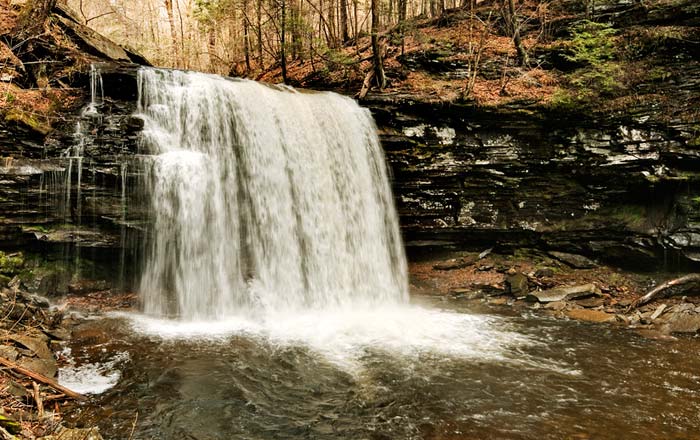
© 2011 Robert Hitchman. All Rights Reserved.
Harrison Wright Falls
Nikon D300s | 20 mm Lens | f/22 @ 1 sec. | ISO 200
Over 170 significant waterfalls cascade down mountain streams of Pennsylvania, with the best concentrated in the Rickets Glen State Park in the northeastern area of the state. Two fast-flowing cascades drop a thousand feet down the Allegheny front to unite in Ricketts Glen State Park and flow south to the Susquehanna River. Here in late April, most of this forest’s deciduous hardwoods have no foliage to block your view of the waterfalls. The vistas are not all monochromatic. Spring color is provided by ferns and moss growing on the walls of the glens and the many large evergreens–pines and hemlocks. In early spring the streams are at their fullest and the falls are most dramatic. A loud and constant roar is heard.
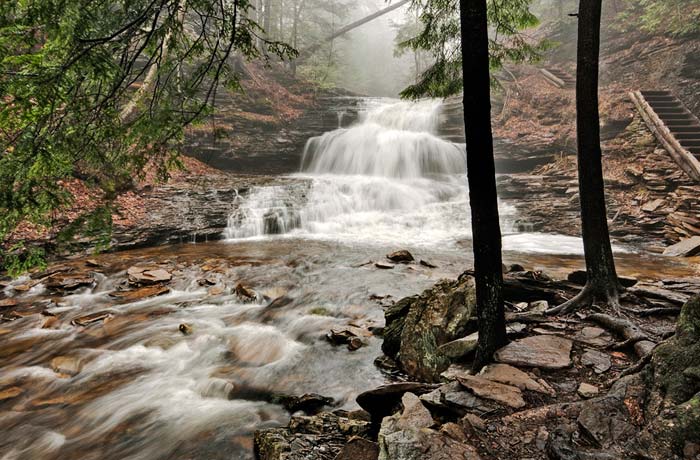
© 2011 Robert Hitchman. All Rights Reserved.
Onodaga Falls
Nikon D300s | 17 mm Lens | f/22 @ 2 sec. | ISO 200
The Ricketts Glen State Park entrance is off Route 487, five miles north of Highway 118, a steep 18% grade for much of the distance. A visitor center sits back in the trees near the entrance. To get to the waterfalls, drive one mile down the paved road, along Lake Jean, to a sign marking a right turn to the Rose Lake parking lot and the Falls Trail, the shortest hike to the nearest waterfall. Because of all the hiking, I packed lightly for this trip. Trail maps are available in boxes at all the trailheads. Every time I photographed another waterfall, I made one extra exposure that included the trail map with my finger pointing to the name of the falls and its location on the map. This is a quick and easy way to attach the correct caption to each photo. I packed both my heavy-duty waterproof hiking boots for the sunny days and my extra heavy-duty hiking boots for the rainy days. Both were well used. Lightweight and collapsible walking sticks can be very useful on these trails. I used my tripod as a walking stick.
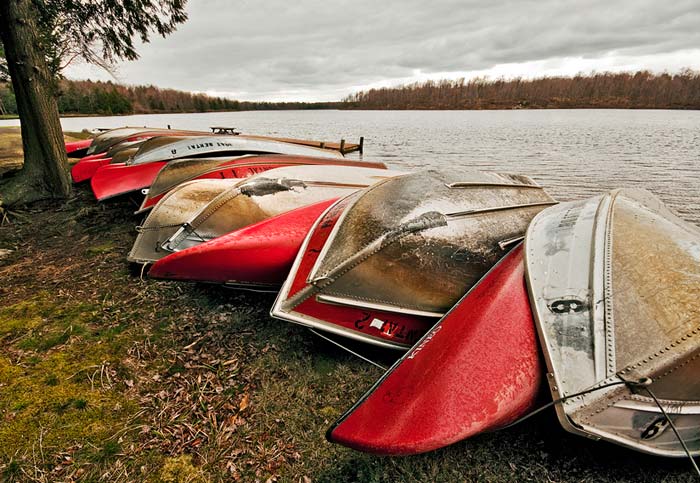
© 2011 Robert Hitchman. All Rights Reserved.
Canoes on Lake Jean
Nikon D300s | 10 mm Lens | f/10 @ 1/40 sec. | ISO 100
Two streams drop from 245-acre Lake Jean. One flows down through Ganoga Glen, while the other flows down Glen Leigh (We call them “canyons” out west.). The streams, both branches of Kitchen Creek, cascade down two canyons/glens that converge at a point called Where Waters Meet. The total drop in elevation from Lake Jean to the bottom of the last waterfall is 1,240 feet. The entire loop trail, from top to bottom and back, is called the Falls Trail and is 8.2 miles long. There are 22 named waterfalls, and many smaller unnamed falls, that are accessible by the Falls Trail.
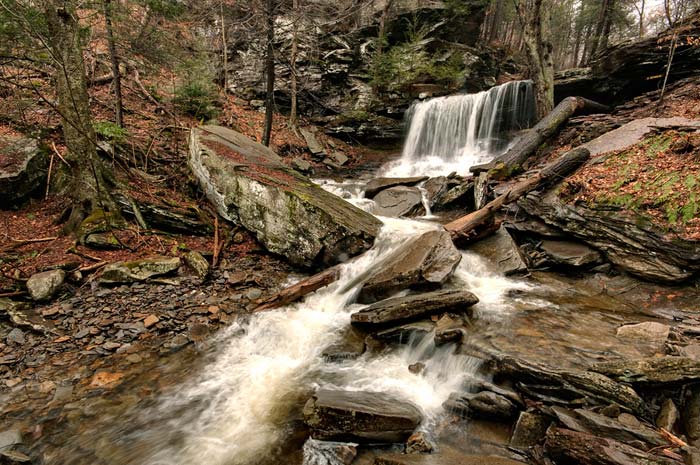
© 2011 Robert Hitchman. All Rights Reserved.
Below B. Reynolds Falls
Nikon D300s | 10 mm Lens | f/22 @ 2 sec. | ISO 200
The Falls Trail is shaped like a giant Y, connected at the top by the Highlands Trail. Park at the Rose Lake parking lot at the top of the West side of the Y or at Beach Lot #2 at the East side of the Y. Stay on the well-marked trails and you won’t get lost. Each waterfall is identified with a small sign and large maps are posted at each trailhead. The Falls Trail closes at sunset, so pack a small flashlight. From either parking area, you can hike down to the confluence and back in 4 hours. If you hike down to the confluence and back up the other side, you will have to walk one extra mile back to your car. Allow 6-7 hours for the 3.2 mile upper loop and you’ll have plenty of time to photograph every waterfall you see. The bottom stem of the Y passes three more waterfalls before reaching the Evergreen parking lot, on the edge of Highway 118. Adams Falls, at the very bottom of the falls trail, is a 36 foot drop through a narrow, twisting gorge. Adams Falls can be reached via the shortest trail of all–only two hundred feet long. The Falls Trail opens sometime in April, after winter snows melt.
Solid hiking boots with an aggressive rubber tread pattern for good grip on slippery stones are a must. High top boots are best if you have weak ankles. Shoes or sandals with flat or leather soles are too slippery on the wet stone stairs. You should be in good physical condition and understand the hazards that can be encountered on these strenuous trails. Be careful and you will enjoy some wonderful photography. Watch out for the small orange and red salamanders on the trails.
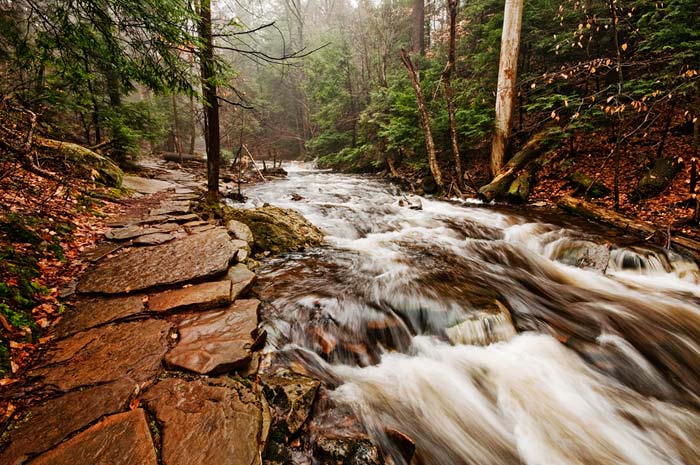
© 2011 Robert Hitchman. All Rights Reserved.
Below Mohawk Falls
Nikon D300s | 10 mm Lens | f/22 @ 1/5 sec. | ISO 200
From the Rose Lake parking area, it’s an easy ten-minute walk from your car, down the trail, across a small bridge, past a series of small cascades where the roar of the falling water starts. The photography begins just above Mohawk falls where the stream narrows and twists down a slope to strike a flat stone in midstream and create a standing wave. Mohawk drops ten feet, makes a turn, and then cascades down a stair-step slope, for a drop of 37 feet. Below the falls, the stream splits and flows around a long wooded island. Like other waterfalls in this park, a bare stump is trapped on the near side of the cascade. Find a spot for your tripod on the upper stairs where you can crop it out of your photograph. These stairs drop over fifty feet to a level trail covered with large gray flagstones (the local Pocono sandstone) to the next waterfall.
Oneida makes a clean drop of 13 feet over a deeply undercut ledge. It can be framed nicely with several hemlocks from a spot a hundred feet farther down the trail. This waterfall made a moody photograph in dense fog on my first day in this park. Waterfalls always look better and photograph better in the fog or rain. To make the most of unpredictable weather conditions, I am always ready for the worst–which would be clear skies, a sunny day in a forest full of frothing waterfalls, and extremely contrasty lighting. Eliminate these exposure problems with HDR, a solid tripod and a cable release for the multiple exposures.
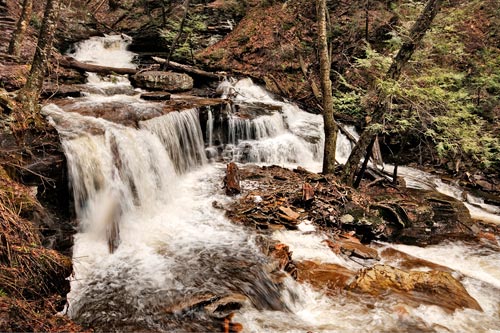
© 2011 Robert Hitchman. All rights reserved. Poppies
Delaware Falls
Nikon D300s | 17 mm Lens | f/20 @ 1 sec. | ISO 400
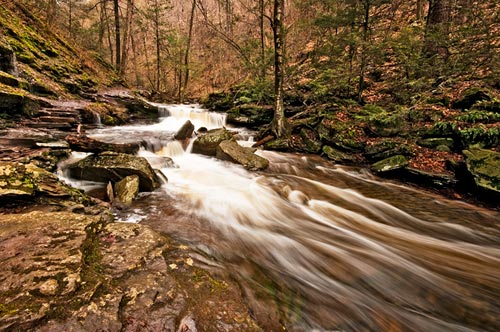
© 2011 Robert Hitchman. All rights reserved. Poppies
Below Mohican Falls
Nikon D300s | 10 mm Lens | f/22 @ 3 sec. | ISO 100
Cayuga drops 11 feet and then splits to pour around a small island in the stream. My favorite viewpoint was close to the rocks beside the trail at the top of the cascade using a 10 mm lens, down close to the water on a collapsed tripod.
Ganoga, the tallest waterfall in the park, drops through a narrow chute to fall 94 feet down a stair-step cascade. The view from the top is disappointing. The trail makes several steep switchback turns and drops to a perfect vantage point near the bottom. When Ganoga is full, a powerful wind is generated by the rush of falling water, blowing a cold mist of spray down the canyon. Stand below this waterfall with an upturned camera and your lens will be drenched in an instant. This is especially bad with a super-wide lens because every drop will be sharply rendered.
Seneca Falls drops 12 feet, then cascades through a point in the canyon where a very narrow trail clings to the rocky edge of a vertical canyon wall, just a few feet above the rushing stream. There are two small islands in the chute below Seneca and just above Delaware. T his short stretch of trail opens to a widening canyon view above Delaware Falls.
Delaware appears to be the widest waterfall in this park. Few trees block the view of this 37 foot fall from the trail. There are several good tripod locations along the trail that circles the edge of the widening stream below Delaware. I needed my 10 mm lens to frame the rim of this waterfall.
The stream between Delaware and Mohican is a short and steep chute, making it seem that they are one long waterfall. Mohican falls 39 feet at a point where a small seasonal side stream flows under a trail bridge to join Kitchen Creek. Fallen logs block the view of this side stream. There are two good flat spots for different views below Mohican.
The trail below Mohican follows closely to the edge of the stream for a long, level walk down to Conestoga, a 17 foot cascade that is solid white when spring runoff fills Kitchen Creek. One good cascade is in the middle of the long downhill walk from Conestoga falls down to Tuscarora falls, a 47 foot cascade dropping over three layers to a clean drop at the bottom. If the spray is light, there is a good spot for your tripod at the base.
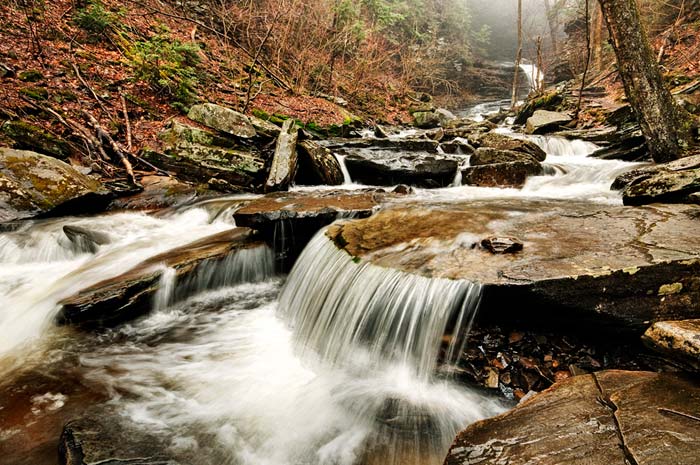
© 2011 Robert Hitchman. All rights reserved.
Cascade Below F. L. Ricketts Falls
Nikon D300s | 14 mm Lens | f/22 @ 2 sec. | ISO 200
Erie is the tenth and last waterfall at the bottom of Ganoga Glen. This waterfall is best photographed from the edge of the narrow trail near the top where the steps are small and steep. Too much spray soaks the lower trail below Erie falls. The canyon narrows below this 47 foot waterfall, making access to the stream difficult along the bottom of the Ganoga Glen Trail.
If you have travel plans to visit Pennsylvania, this is a stop worth making.
The waterfalls in Pennsylvania’s Ohioplyle State Park and Worlds End State Park, plus Falling Water, Frank Lloyd Wright’s design for a custom-built home, built on a waterfall in the Pennsylvania woods, are also great places to photograph nearby.
by Robert Hitchman, Photograph America

Leave a Reply